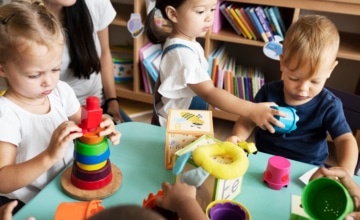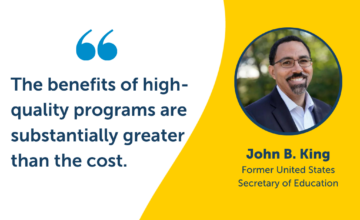Junlei Li, Harvard University

Abstract
In efforts to promote equitable access to programs and services for young children and families, concepts and measures of quality rely heavily on the “counting” of both material and professional resources (e.g., facility and curricula, degrees and credentials). However, looking for high-quality practices in unexpected places—with people and in communities whose limited access to such resources necessitates human resourcefulness—is a reminder to dive deeper and discover what really “counts” about the human capacity to care. To nurture and grow such potential is the important task in the quest to achieve quality with equity.
Imagine an early childhood educator who serves in a culturally and economically diverse, historically underserved neighborhood. She is most likely a woman. She has grown up and still lives there. She connects with the families and children in her care and shares their challenges and joy. In her daily interactions, she strives to encourage children’s learning, support the families’ growth, and knows the community. Her wages barely rise above the poverty threshold and are low relative to what it could be in other fields given her qualifications. She works in relative isolation from her professional peers (e.g., a family child care provider) and receives limited support from outside resources except for compliance tasks like ratings and evaluations. Though her early learning setting does not have new and customized furnishings, sunny and spacious rooms, or a fancy playground, she is resourceful in making use of whatever she has access to, recycling and reusing household materials for creative play. Despite her efforts, her program does not rise above the lower-tier of child care quality ratings. She longs for a pathway to higher education but has limited options for upward mobility. With a family to support on her own, she can neither afford the time nor the cost even if she could prepare herself academically. Despite the lack of formal recognition, she senses her impact through the small, incremental progress she observes in her children, and the occasional genuine thanks she receives from the parents from her community.
As an early childhood professional, you may share some or most of these characteristics—and you would almost certainly know peers who fit such descriptions. For children, families, and communities, she represents the millions of professionals who strive to make real a vision of early childhood that promotes quality with equity (National Association for the Education of Young Children [NAEYC], 2019). Achieving equity for children starts with recognizing the diversity and strengths of the frontline helpers—those who directly interact with and support children and families in their daily work. To help the helpers, directors, trainers, researchers, or policymakers all need to collectively foster a community of practice that supports and advocates for an equitable and inclusive early childhood profession.
Normative Assumptions About Quality
One can start with the openness, humility, and confidence to re-examine the normative assumptions one has about quality—both in terms of care setting and people. Much of the early childhood knowledge base is built on middle-class, Euro-American norms (Henrich, Heine, & Norenzayan, 2010; NAEYC, 2019). Because this population has been privileged with both material and professional resources, the definitions and measures of quality are thus closely associated with the availability of resources (see Figure 1). Abundance of both material and professional resources are seen as necessary prerequisites to a high quality rating, and the absence of either can preclude a program from higher ratings.
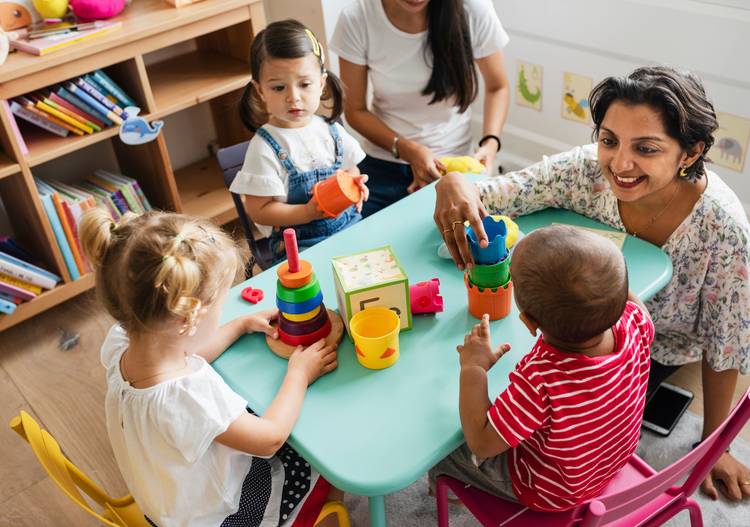
Achieving equity for children starts with recognizing the diversity and strengths of the helpers on the frontlines.
Such a system often scores and weighs furnishings and instructional materials similarly to how it scores teacher–child interactions, and recognizes and rewards credentials and degrees significantly more than experience and actual practice. Rigid and dogmatic adherence to these normative quality assumptions may maintain or enlarge, rather than narrow, the historical inequity between providers who serve middle and upper-class children and those who serve the rest. Under such a system, it is difficult for providers and teachers to receive the recognition that their work is worthwhile in the eyes of the evaluative and regulatory system so long as their resources and credentials do not match the normative standards (Tschannen-Moran, Hoy, & Hoy, 1998; and see also multiple perspectives debated in Zigler, Gilliam, & Barnett, 2011).
Although resource gaps are real and advancing equity includes improving access to material and professional supports, resources by themselves should not be the absolute, insurmountable thresholds that arbitrate quality. Over the last two decades, what has become clearer in the science of early childhood education is that human relationships, built through simple, daily interactions between educators and children and families, are the essential or “active” ingredients of quality (Hamre, 2014; Li & Julian, 2012; National Scientific Council on the Developing Child, 2004, 2015; Osher, Cantor, Berg, Steyer, & Rose, 2018). Normative measures of quality—whether they are based on staff credentials or curricular materials or space and furnishings—do not consistently or significantly predict actual child outcomes (see reviews and debates in Zigler et al., 2011).
Re-Examining Quality
The research evidence shows increasing uncertainty, rather than certainty, that the normative quality measures are in fact capturing everything that truly matters. Common measures and indicators used in the current Quality Rating and Improvement System (often abbreviated as QRIS) across many states have few, weak, and inconsistent associations with children’s developmental outcomes (Brunsek et al., 2017; Curby et al., 2009; Mashburn et al., 2008; Perlman et al., 2016; Sabol, Soliday Hong, Pianta, & Burchinal, 2013). The quality thresholds (often referred to as “star” levels, akin to quality rating of hotels and restaurants) often do not sufficiently differentiate both process quality measures, such as classroom interactions, or outcome measures, such as cognitive or social and emotional development (Burchinal, 2018; Burchinal, Zaslow, & Tarullo, 2016; Votruba-Drzal & Miller, 2016). Collectively, these uncertain measures are used to determine the star levels, and the star levels in turn determine financial incentives and punitive actions for both federally funded early childhood programs (e.g., Head Start) and state-subsidized providers (e.g., family child care providers).
Figure 1. Illustration of the Normative Assumption That High Resources Equates With High Quality
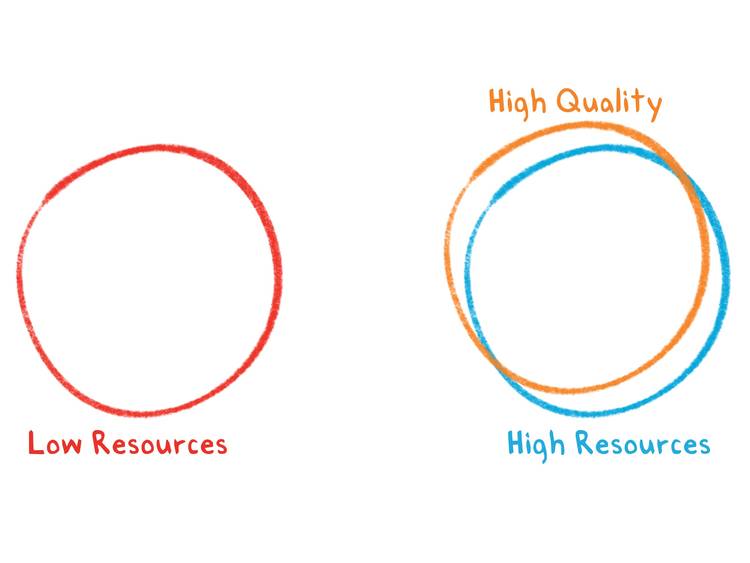
To attach high stakes with uncertain metrics may seem an expedient shortcut to present the appearance of objectivity and impartiality to meet or appease the demands of accountability, as it often happens within bureaucratic systems (Porter, 1995). In early childhood contexts, such shortcuts risk imposing a “tyranny of metrics” (Muller, 2018) on the early childhood system in ways that may perpetuate or even exacerbate inequity in the name of achieving quality. For example, must the number of math blocks or reading books in a classroom reach a predetermined numerical threshold to warrant a high quality score? Or, must child care providers remain at a lower tier quality level just because they cannot afford to pay or keep a credentialed teacher’s aide, as stipulated by staff quality regulations? Such impacts are already evident in the K-12 system in terms of teacher stress, recruitment, and other consequences (Berryhill, Linney, & Fromewick, 2009; Clotfelter, Ladd, Vigdor, & Diaz, 2004; de Wolf & Janssens, 2007; Dworkin & Tobe, 2014; Jones & Egley, 2004; von der Embse, Pendergast, Segool, Saeki, & Ryan, 2016).
This phenomenon, not just limited to early childhood, is aptly captured in a quote attributed to Albert Einstein, “What counts cannot always be counted, and what can be counted does not always count.” Beyond the mere accounting of resources, resourcefulness—the way educators make use of their materials, knowledge, or skill in their interactions with children—is more likely the determinant of ultimate developmental impact on children. The evolution of quality measures is beginning to reflect this emerging understanding. For example, the Infant/Toddler Environmental Rating Scale (Harms, Cryer, Clifford, & Yazejian, 2017), commonly used across states in quality rating systems, has evolved into its third version since its inception in 1980. The developers listed the following among the primary motivations for the update “ITERS-R requires close attention to the number and quality of accessible materials. ITERS-3 requires less attention to accessible materials and more attention to how the teachers use the materials to foster children’s learning.” (p. 3)
For administrators and policymakers, understanding the difference between “resources” and “resourcefulness” calls for an openness to re-examine quality using a more equitable lens. Quality, particularly as manifested by the human relationships among educators, children, and families, can be found in both communities with high and low access to resources (see Figure 2).
Equitable Measurement of Quality
Policymakers who have the power to influence provider compensation need to be particularly critical in applying high-stakes outcomes (e.g., tying subsidy reimbursement rates with quality ratings) using uncertain measures. In order to measure and improve quality equitably, it is necessary to develop tools to recognize, incentivize, and support quality in ways that build on the strengths of providers in low-resource communities (e.g., family child care framework).
Figure 2. Illustration of the Possibility That High-Quality Practices Can Exist in Both Low and High Resource Contexts
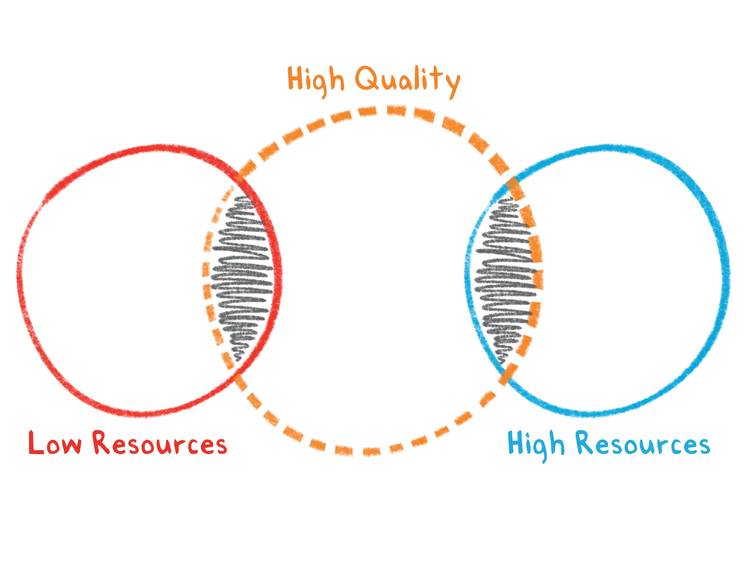
For educators and providers who serve communities with limited resources, moving beyond normative assumptions means remembering that they themselves matter the most to children and families, not just the things they can or cannot afford. Such a view of quality can strengthen the helpers’ professional identity with the affirmation that their daily relational interactions already embody a variety of practices that are helpful to children and families. This is especially necessary if the system in which they work does not readily give sufficient “credit” to such practices or strengths. Few can sustain such affirmation alone, but collectively, educators can build and sustain “communities of practice” among people who know each other and share a common setting (within a provider or a neighborhood.) Such communities do not skirt real challenges that exist in professional practice, but can approach such challenges by sharing and recognizing authentic strengths, reflecting on promising practices, and celebrating incremental progress (Cooperrider & Whitney, 2005; Pascale, Sternin, & Sternin, 2010; Wenger, McDermott, & Snyder, 2002). Those who have the role of training, teaching, and coaching educators and providers can play an instrumental role in convening, facilitating, and advocating for resources and investments for such community-based professional development.
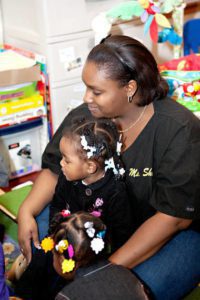
Human relationships, built through simple, daily interactions between educators and children and families, are the essential or “active” ingredients of quality. Photo: press/production/photos/kiwi/f-b c-p-p 4383
As early childhood professionals strive, collectively, to achieve and sustain quality with equity (NAEYC, 2019), practitioners, researchers, and policymakers can recognize that quality experiences for diverse children and families depend on supporting diverse educators who serve children. None of these professionals can make a lasting and positive impact in equity (or pursue other ideals in early childhood education) if their decisions, actions, and investments skip over the “helpers” in the middle. The early childhood profession has long embodied what the educational television pioneer Fred Rogers described as a “child-first” ethics:
Please think of the children first: If you ever have anything to do with their entertainment, their food, their toys, their custody, their day or night care, their health care, their education—listen to the children, learn about them, learn from them. Think of the children first. (Rogers, 2003, p. 168)
In order to truly serve children and families across the full spectrum of diversity, administrators, researchers, and policymakers can expand upon that vision to include educators:
Please think of the helpers next. If you ever have anything to do with their learning and growing, their living wage, their training, their evaluation, their workload, their health care, their respite—listen to the helpers, learn about them, learn from them. Think of the helpers next.
Let all the members of the infant–family field be as invested in advancing equity and diversity for the educators as they are for the children and families.
Author
Junlei Li, PhD, is the Saul Zaentz Senior Lecturer in Early Childhood Education at Harvard Graduate School of Education. His research and practice focus on understanding and supporting the work of helpers—those who serve children and families on the frontlines of education and social services. Dr. Li studies high-quality practices in low-resource settings, including orphanages, child care, classrooms, and community youth programs. He developed the Simple Interactions( www.simpleinteractions.org) approach to help identify what ordinary people do extraordinarily well with children in everyday moments. With that as the basis for promoting positive system change, Dr. Li frequently delivers keynote presentations and workshops for national, state, and international conferences. Dr. Li’s work is significantly influenced and inspired by the pioneering work of Fred Rogers (creator of Mister Rogers’ Neighborhood). He previously served as the co-director and faculty chair of the Fred Rogers Center at Saint Vincent College.
Acknowledgments
I wish to thank the intellectual contributions over time from my collaborator Dr. Dana Winters of the Fred Rogers Center and research contributions from my students Sophie Barnes, Anna Kirby, Lily Fritz, and Douglas Mosher at Harvard Graduate School of Education.
Suggested Citation
Li, J. (2019). Achieving quality with equity: Recognizing and supporting high-quality practices and professionals in low-resource communities. ZERO TO THREE Journal, 40(2), 5–9.
References
Berryhill, J., Linney, J. A., & Fromewick, J. (2009). The effects of education accountability on teachers: Are policies too stress provoking for their own good? International Journal of Education Policy & Leadership, 4(5), 1–14.
Brunsek, A., Perlman, M., Falenchuk, O., McMullen, E., Fletcher, B., & Shah, P. (2017). The relationship between the Early Childhood Environment Rating Scale and its revised form and child outcomes: A systematic review and meta-analysis. PLOS One, 12(6), e0178512.
Burchinal, M. (2018). Measuring early care and education quality. Child Development Perspectives, 12(1), 3–9.
Burchinal, M., Zaslow, M., & Tarullo, L. (2016). Quality thresholds, features, and dosage in early care and education. Monographs of the Society for Research in Child Development, 81(2).
Clotfelter, C. T., Ladd, H. F., Vigdor, J. L., & Diaz, R. A. (2004). Does school accountability system make it more difficult for low-performing schools to attract and retain high-quality teachers? Journal of Policy Analysis and Management, 23(2), 251–271.
Cooperrider, D. L., & Whitney, D. (2005). Appreciative inquiry: A positive revolution in change. San Francisco, CA: Berrett-Koehler.
Curby, T. W., LoCasale-Crouch, J., Konald, T., Pianta, R. C., Howes, C., Burchinal, M.,…Barbarin, O. (2009). The relations of observed pre-k classroom quality profiles to children’s achievement and social competence. Early Education and Development, 20(2), 346–372.
de Wolf, I. F., & Janssens, F. J. G. (2007). Effects and side effects of inspections and accountability in education: an overview of empirical studies. Oxford Review of Education, 33(3), 379–396.
Dworkin, A., & Tobe, P. (2014) The effects of standards based school accountability on teacher burnout and trust relationships: A longitudinal analysis. In D. V. Maele, P. B. Forsyth & M. V. Houtte (Eds.), Trust and school life (pp. 121–143). New York, NY: Springer.
Hamre, B. K. (2014). Teachers’ daily interactions with children: An essential ingredient in effective early childhood programs. Child Development Perspectives, 8(4), 223–230.
Harms, T., Cryer, D., Clifford, R., & Yazejian, N. (2017). Infant/toddler environment rating scale (3rd ed.). New York, NY: Teachers College Press.
Henrich, J., Heine, S. J., & Norenzayan, A. (2010). The weirdest people in the world? Behavioral and Brain Sciences, 33, 61–83.
Jones, B., & Egley, R. (2004). Voices from the frontlines: Teachers’ perceptions of high-stakes testing. Education Policy Analysis Archives, 12(39) 1–34.
Li, J., & Julian, M. (2012). Developmental relationships as the active ingredient: A unifying working hypothesis of “what works” across intervention settings. American Journal of Orthopsychiatry, 82(2), 157–166.
Mashburn, A. J., Pianta, R. C., Hamre, B. K., Downer, J., Barbarin, O. A., Bryant, D., & Howes, C. (2008). Measures of classroom quality in pre-kindergarten and children’s development of academic, language and social skills. Child Development, 79, 732–749.
Muller, J. (2018). The tyranny of metrics. Princeton, NJ: Princeton University Press.
National Association for the Education of Young Children. (2019). Advancing equity in early childhood education: A position statement. Washington, DC: Author.
National Scientific Council on the Developing Child. (2004). Young children develop in an environment of relationships: Working paper no. 1. Developing Child
National Scientific Council on the Developing Child. (2015). Supportive relationships and active skill-building strengthen the foundations of resilience: Working paper no. 13. Developing Child
Osher, D., Cantor, P., Berg, J., Steyer, L., & Rose, T. (2018). Drivers of human development: How relationships and context shape learning and development. Applied Developmental Science, DOI: 10.1080/10888691.2017.1398650
Pascale, R., Sternin, J., & Sternin, M. (2010). The power of positive deviance: How unlikely innovators solve the world’s toughest problems. Boston, MA: Harvard University Press.
Perlman, M., Falenchuk, O., Fletcher, B., McMullen, E., Beyene, J., & Shah, P. S. (2016). A systematic review and meta-analysis of a measure of staff/child interaction quality (the Classroom Assessment Scoring System) in early childhood education and care settings and child outcomes. PLoS One, 11(12), e0167660.
Porter, T. (1995). Trust in numbers: The pursuit of objectivity in science and public life. Princeton, NJ: Princeton University Press.
Rogers, F. (2003). The world according to Mister Rogers: Important things to remember. New York, NY: Hyperion.
Sabol, T. J., Soliday Hong, S. L., Pianta, R. C., & Burchinal, M. R. (2013). Can rating pre-K programs predict children’s learning. Science, 341(6148), 845–846.
Tschannen-Moran, M., Hoy, A. W., & Hoy, W. K. (1998). Teacher efficacy: Its meaning and measure. Review of Educational Research, 68(2), 202–248.
von der Embse, N. P., Pendergast, L. L., Segool, N., Saeki, E., & Ryan, S. (2016). The influence of test-based accountability policies on school climate and teacher stress across four states. Teaching and Teacher Education, 59, 492–502.
Votruba-Drzal, E., & Miller, P. (2016). Reflections on quality and dosage of preschool and children’s development. In M. Burchinal, M. Zaslow, & L. Tarullo (Eds.), Quality thresholds, features, and dosage in early care and education. Monographs of The Society for Research in Child Development, 81(2).
Wenger, E., McDermott R., & Snyder, W. (2002). Cultivating communities of practice. Boston, MA: Harvard Business Review Press.
Zigler, E., Gilliam, W., & Barnett, B. (2011). The pre-k debates: Current controversies and issues. Baltimore, MD: Brookes.


